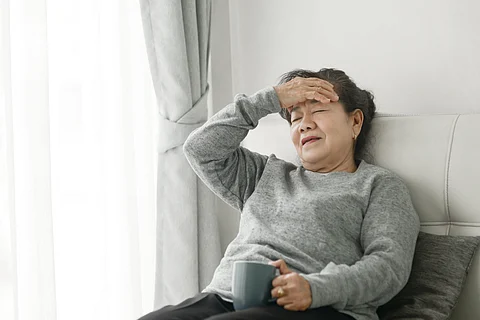Balancing your blood sugar and reducing the risk of health issues can be a challenge for people with diabetes when a cold or the flu strikes.
Find out what to eat and drink when you’re sick, how to take care of yourself and how to put together a diabetes sick day plan -- including when to call your doctor.
What to eat
The U.S. Centers for Disease Control and Prevention suggests people with diabetes eat about 50 grams of carbohydrates every four hours when they're sick to keep blood sugar from dipping too low.
Diana Isaacs, an endocrine clinical pharmacy specialist at the Cleveland Clinic's Endocrinology & Metabolism Institute, suggests:
Soup or broth
Crackers
Bread
Ice pops
Unsweetened applesauce
Soup and broth can help fulfill both your liquid and carb requirements.
“For those with type 1 diabetes or taking insulin, it’s important to take in some carbohydrates and continue taking insulin,” Isaacs said. “If not eating and drinking as usual, a person may also be at risk of low glucose levels.”
The American Diabetes Association (ADA) says it can be helpful to follow the 15-15 rule: Eat 15 grams of carbs, then check your blood sugar 15 minutes after that.
“Foods that are easy on the stomach like bread [and] crackers … can be helpful for those with nausea or vomiting,” Isaacs said.
Just like soup and broth, ice pops and unsweetened applesauce can help you get enough carbs and liquids while sick. They're good choices if you feel too ill to eat solids, Isaacs said.
What to drink
“When feeling sick, the most important thing is to stay well hydrated," Isaacs said. Drinking water and/or sugar-free fluids is important.” Besides plain water, gingerade, ginger ale and tea are also good choices.
University of Alabama-Birmingham (UAB) Medicine says it's important to pay attention to your fluid intake, because dehydration can raise blood sugar levels.
When blood sugar spikes, it increases the risk for diabetic ketoacidosis (DKA), according to the Cleveland Clinic. Isaacs noted that DKA “can be a life-threatening complication.”
If you’re having trouble keeping enough water down to avoid dehydration, tea or gingerade may settle your stomach, Isaacs said.
In fact, ginger has been used to help with nausea and vomiting in traditional medicine, according to Mount Sinai Health. It’s also shown promise for easing stomach queasiness in a number of modern studies.
In type 1 diabetes, you may experience a lack of insulin in the blood, which can lower electrolyte levels, the Mayo Clinic says.
Of course, dehydration from a fever, vomiting or lack of fluid intake can also reduce your body’s electrolyte levels, according to the Cleveland Clinic.
“Low-sugar sports drinks or an electrolyte-replacement [drinks] …can be good choices because they include electrolytes," Isaacs said.
Self-care tips
Besides staying hydrated, it's important to get plenty of rest and monitor your glucose often, Isaacs advised.
“Wearing a continuous glucose monitor [CGM] can make it easier to monitor glucose and can alert for high or low levels," she said. "If not using a CGM, it’s recommended to check glucose with finger sticks at least every three to four hours.”
When to call your doctor
To protect yourself from DKA, call your doctor if you have moderate or high ketones or glucose levels over 300mg/dL for several hours that don't come down even with additional insulin, Isaacs advised.
In addition, if you notice any of the following symptoms, the CDC says you should immediately go to the emergency room:
A temperature over 101 degrees Fahrenheit for 24 hours
Inability to keep liquids down for more than four hours
Inability to keep food down for more than 24 hours
Vomiting or severe diarrhea for more than six hours
Difficulty thinking clearly
Trouble breathing
Loss of 5 pounds or more
“People with diabetes should work with their health care team or diabetes care and education specialist to develop an individualized sick care plan,” Isaacs advised. “This should include things like when to call their health care provider, how often to check glucose levels, preferred foods and drinks to consume, how to adjust insulin or medications, when to check for ketones [and] what over-the-counter medications are preferred for treating colds and flus."
Once your sick day game plan is in place, Isaacs suggested gathering key supplies ahead of time so you’re well prepared when illness kicks in.
“It’s also good to have a sick day kit ready,” she said. “Examples of what may be included are a glucose monitoring device, ketone test strips, hypoglycemia treatment like glucose tablets or gels, glucagon, thermometer, sugar-free cough drops, syrups or throat lozenges, and health care team contacts."
SOURCE: Diana Isaacs, PharmD, director, education and training in diabetes technology, Cleveland Clinic



